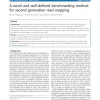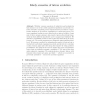422 search results - page 68 / 85 » Cloud computing for comparative genomics |
BMCBI
2011
13 years 2 months ago
2011
Background: Second generation sequencing technologies yield DNA sequence data at ultra high-throughput. Common to most biological applications is a mapping of the reads to an almo...
HPDC
2009
IEEE
14 years 5 months ago
2009
IEEE
Advances in the development of large scale distributed computing systems such as Grids and Computing Clouds have intensified the need for developing scheduling algorithms capable...
RECOMB
2005
Springer
14 years 11 months ago
2005
Springer
Whether common ancestors of eukaryotes and prokaryotes had introns is one of the oldest unanswered questions in molecular evolution. Recently completed genome sequences have been u...
BIBM
2008
IEEE
14 years 5 months ago
2008
IEEE
Alternative splicing is a mechanism for generating different gene transcripts (called isoforms) from the same genomic sequence. Finding alternative splicing events experimentally ...
SAC
2003
ACM
14 years 4 months ago
2003
ACM
Existing sequence comparison software applications lack automation, abstraction, performance, and flexibility. Users need a new way of studying and applying sequence comparisons i...


